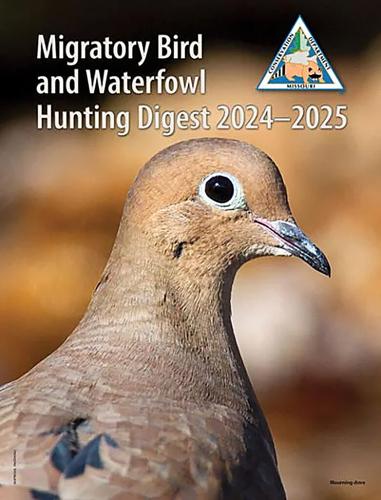While white-tailed deer and wild turkeys generate the greatest fanfare among the fall hunting seasons, those who hope to fill their game bags in different sports have ample options each autumn.
Led by the waterfowl that navigate the Mississippi River Flyway on their southbound route, migratory birds make up a significant portion of Missouri’s fall hunting calendar. Like the deer and turkey, the migrators have their own annual publications from the state Department of Conservation outlining the regulations for the hunting seasons.
The mourning dove that graces the digest’s cover this year may seem like an easy target as it waddles along the ground, but in flight they maneuver like mini fighter jets. Like all birds, they rely on exceptional eyesight, and they quickly learn to avoid areas where they might encounter people with firearms.
The 90-day dove hunting season opened Sept. 1 and continues through Nov. 29. Shooting hours are from 30 minutes before sunrise until sunset each day. Hunters may take 15 doves daily and are allowed to harvest mourning doves, white-winged doves and Eurasian collared doves.
Hunting seasons for sora and Virginia rails and Wilson’s (common) snipe also opened Sept. 1. The marsh- and swamp-dwellers are about the same size as mourning doves, but with a plumper body. The daily limit is 25 for rails and eight for snipe. The rail hunting season closes Nov. 9, while snipe hunting is legal until Dec. 16. The three birds are presented in the digest with another member of the sandpiper family; open season for woodcocks is Oct. 18 through Dec.1 with a daily limit of three.
All this may seem a little complicated, but it’s elementary compared to sorting out the seasons and regulations for waterfowl hunting in the state. The rules begin easy enough with the teal season, which allows hunting of the smaller, early migrating ducks from Sept. 7 through 22. The daily limit is six birds.
Seasons for other ducks and geese are regulated in three hunting zones as migrations move south with colder temperatures. The north zone includes roughly the upper one-third of the state, with I-70 forming most of the area’s southern border.
Hunting dates in the north and middle zones open Nov. 2 for ducks and coots. The southern zone opener is Nov. 28. The hunting seasons are 60 days long, but the middle and south zones both have five-day, in-season breaks that extend hunting into January.
Now for the tricky part: Duck hunters may harvest six ducks daily, but no more than four mallards (no more than two hens), three wood ducks, two black ducks, two canvasbacks, two hooded mergansers, two redheads, two scaup (for the first 45 days, only one for the last 15 days) one mottled duck and one pintail. The daily bag also can include 15 coots.
Goose hunting season is a little less complex because there are fewer unique species that visit Missouri. Early hunting for Canada geese and brant is open from Oct. 5 through 13. Once the regular season opens Nov. 11, hunters can take three Canada geese and brant, two white fronted geese and up to 20 light geese, which include snow, blue and Ross’s geese.
Once that season closes Feb. 6, a special conservation order allows hunters to take an unlimited number of light geese every day until April 30.
Migratory bird hunters are required to purchase a small game hunting permit ($10.50 for residents) and a migratory bird hunting permit ($6.50). Those adding duck or goose hunting to their plans also must have a federal duck stamp. The traditional paper stamps are available at some post offices for $25. An electronic version can be purchased online for $32.
John Winkelman has been writing about outdoors news and issues in Jefferson County for more than 30 years and was the Associate Editor for Outdoor Guide Magazine. If you have story ideas, e-mail ogmjohnw@aol.com, and you can find more outdoor news and updates at johnjwink.com.





